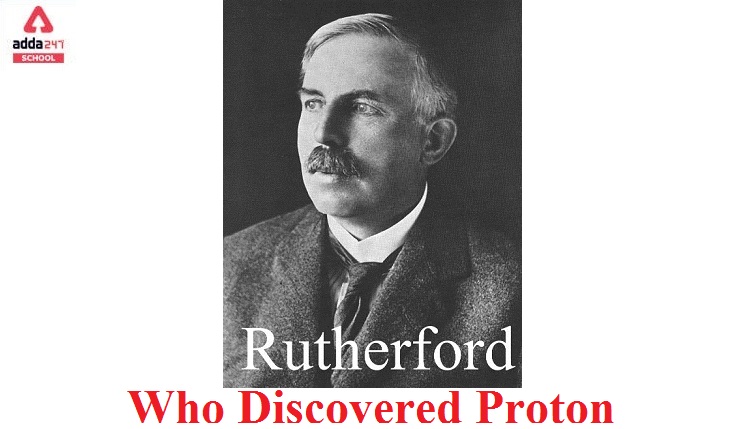Who Discovered Proton
Who discovered Proton: The discovery of the proton is credited to Ernest Rutherford, a New Zealand-born physicist, in the early 20th century. In 1919, Rutherford conducted a series of experiments known as the gold foil experiment, where he bombarded a thin sheet of gold with alpha particles (positively charged particles).
During these experiments, Rutherford observed that some of the alpha particles were deflected at large angles, while others passed through the gold foil with little deflection. He concluded that most of the mass of an atom is concentrated in a small, dense, and positively charged nucleus at the center.
Based on his observations, Rutherford proposed the existence of a positively charged particle within the nucleus, which he named the “proton” in 1920. His groundbreaking work laid the foundation for our understanding of atomic structure and the composition of matter.
Proton Discovered by Rutherford or Goldstein
The discovery of the proton is generally attributed to Ernest Rutherford. In the early 20th century, Rutherford conducted experiments on the scattering of alpha particles by thin metal foils. Through these experiments, he observed that some alpha particles were deflected at large angles, indicating the presence of a small, dense, positively charged nucleus within the atom. Rutherford’s work in this area laid the foundation for our understanding of the atomic nucleus and the existence of protons.
On the other hand, Johann Wilhelm Geiger and Hans Geiger, working with Ernest Marsden under Rutherford’s guidance, conducted the famous gold foil experiment in 1909. This experiment provided crucial evidence for the nuclear model of the atom, which ultimately led to the discovery of the proton as a component of the atomic nucleus.
So, while Rutherford is credited with the discovery of the proton, the gold foil experiment conducted by Geiger and Marsden played a key role in confirming its existence. Wilhelm Goldstein, however, is not typically associated with the discovery of the proton.
What is Proton
A proton is a subatomic particle having a mass slightly less than that of a neutron and a positive electric charge of +1e elementary charge. Protons and neutrons, each with a mass of around one atomic mass unit, are referred to collectively as “nucleons.”
Every atom has one or more protons in its nucleus. They form an essential component of the nucleus. The atomic number refers to the number of protons in the nucleus, which is the defining attribute of an element. Because each element has a different number of protons, it has a different atomic number.
Read About: Bar Magnet
Who discovered protons according to NCERT Class 9?
Ernest Rutherford published his discoveries demonstrating the existence of the proton, almost a hundred years ago. For decades, the proton was thought to be a fundamental particle. However, tests have revealed that the proton has a complicated internal structure that varies on how you look at it, or rather how hard you hit it. It is since researchers at the SLAC and DESY laboratories began firing electrons into protons in the 1960s. However, a century later, there is still plenty to discover about the proton. Read in-depth articles about what we know and don’t know about the proton in the newest edition of the CERN Courier.
The 1919 book “Rutherford, Transmutation, and the Proton” chronicles the circumstances that led to Ernest Rutherford’s discovery of the proton. In “The proton laid bare,” is about scientists’ concepts regarding proton.
Read About: Ozone Hole
Who discovered proton Goldstein or rutherford? Early Facts
Canal rays were discovered in 1886 by Eugen Goldstein, who demonstrated that they were positively charged particles (ions) created by gases. However, unlike the negative electrons found by J. J. Thomson, particles from different gases had varying charge-to-mass ratios (e/m) and so could not be identified with a single particle. In ionised gases, Wilhelm Wien identified the hydrogen ion as the particle with the highest charge-to-mass ratio in 1898.
Prout’s idea that hydrogen was the building block of all elements impacted Rutherford, who recognised hydrogen to be the simplest and lightest element. Rutherford gave the hydrogen nucleus H+ a special designation as a particle after discovering that the hydrogen nucleus is present in other nuclei as an elementary particle. He suspected that hydrogen, the lightest element, had only one of these particles. He named this new nucleus fundamental building blocks the proton, after the neuter singular of the Greek word “first,” v. Rutherford, on the other hand, was thinking of Prout’s word protyle.
Proton was discovered by whom in which year?
Beginning on August 24, 1920, Rutherford presented at the British Association for the Advancement of Science’s Cardiff meeting. The nitrogen reaction was first proposed by Rutherford as 14N + 14C + + H+. Oliver Lodge asked him for a new term for the positive hydrogen nucleus at the meeting to avoid misunderstanding with the neutral hydrogen atom. He proposed both proton and proton at first. Following Prout’s word “protyle,” Rutherford later claimed that the meeting had accepted his recommendation that the hydrogen nucleus is dubbed “proton.” The term “proton” was first used in the scientific literature in 1920.
Read About: Global Warming
Who Discovered Protons
The discovery of protons is attributed to Sir Ernest Rutherford, a New Zealand-born physicist, in the early 20th century. Rutherford conducted a series of experiments in the early 1900s, most notably the famous gold foil experiment in 1909. In this experiment, he and his colleagues bombarded a thin sheet of gold foil with alpha particles (positively charged particles).
The surprising result of the experiment was that some alpha particles were deflected at large angles or even bounced back, which contradicted the prevailing model of the atom at the time, known as the “plum pudding” model. This led Rutherford to propose a new atomic model in which the majority of an atom’s mass is concentrated in a tiny, dense, positively charged nucleus, while negatively charged electrons orbit the nucleus at a distance.
The positively charged particle at the center of the atom, which Rutherford identified as the source of the repulsion experienced by the positively charged alpha particles, was named the proton. Rutherford’s work laid the foundation for our modern understanding of atomic structure, and he was awarded the Nobel Prize in Chemistry in 1908 for his contributions to the field of nuclear physics.
Proton ki khoj kisne ki thi
प्रोटॉन की खोज का श्रेय 20वीं सदी की शुरुआत में न्यूजीलैंड में जन्मे भौतिक विज्ञानी सर अर्नेस्ट रदरफोर्ड को दिया जाता है। रदरफोर्ड ने 1900 के दशक की शुरुआत में प्रयोगों की एक श्रृंखला आयोजित की, जिनमें से सबसे उल्लेखनीय 1909 में प्रसिद्ध सोने की पन्नी का प्रयोग था। इस प्रयोग में, उन्होंने और उनके सहयोगियों ने अल्फा कणों (सकारात्मक चार्ज कणों) के साथ सोने की पन्नी की एक पतली शीट पर बमबारी की।
प्रयोग का आश्चर्यजनक परिणाम यह था कि कुछ अल्फा कण बड़े कोणों पर विक्षेपित हो गए या वापस उछल गए, जो उस समय परमाणु के प्रचलित मॉडल का खंडन करता था, जिसे “प्लम पुडिंग” मॉडल के रूप में जाना जाता था। इसने रदरफोर्ड को एक नए परमाणु मॉडल का प्रस्ताव देने के लिए प्रेरित किया जिसमें परमाणु का अधिकांश द्रव्यमान एक छोटे, घने, सकारात्मक रूप से चार्ज किए गए नाभिक में केंद्रित होता है, जबकि नकारात्मक रूप से चार्ज किए गए इलेक्ट्रॉन कुछ दूरी पर नाभिक की परिक्रमा करते हैं।
परमाणु के केंद्र में धनात्मक रूप से आवेशित कण, जिसे रदरफोर्ड ने धनात्मक रूप से आवेशित अल्फा कणों द्वारा अनुभव किए गए प्रतिकर्षण के स्रोत के रूप में पहचाना, को प्रोटॉन नाम दिया गया। रदरफोर्ड के काम ने परमाणु संरचना की हमारी आधुनिक समझ की नींव रखी और परमाणु भौतिकी के क्षेत्र में उनके योगदान के लिए उन्हें 1908 में रसायन विज्ञान में नोबेल पुरस्कार से सम्मानित किया गया।









 CUET Geography Previous Year Question Pa...
CUET Geography Previous Year Question Pa...
 CUET Biology Previous Year Question Pape...
CUET Biology Previous Year Question Pape...
 CUET Physics Question Paper 2026: Downlo...
CUET Physics Question Paper 2026: Downlo...














